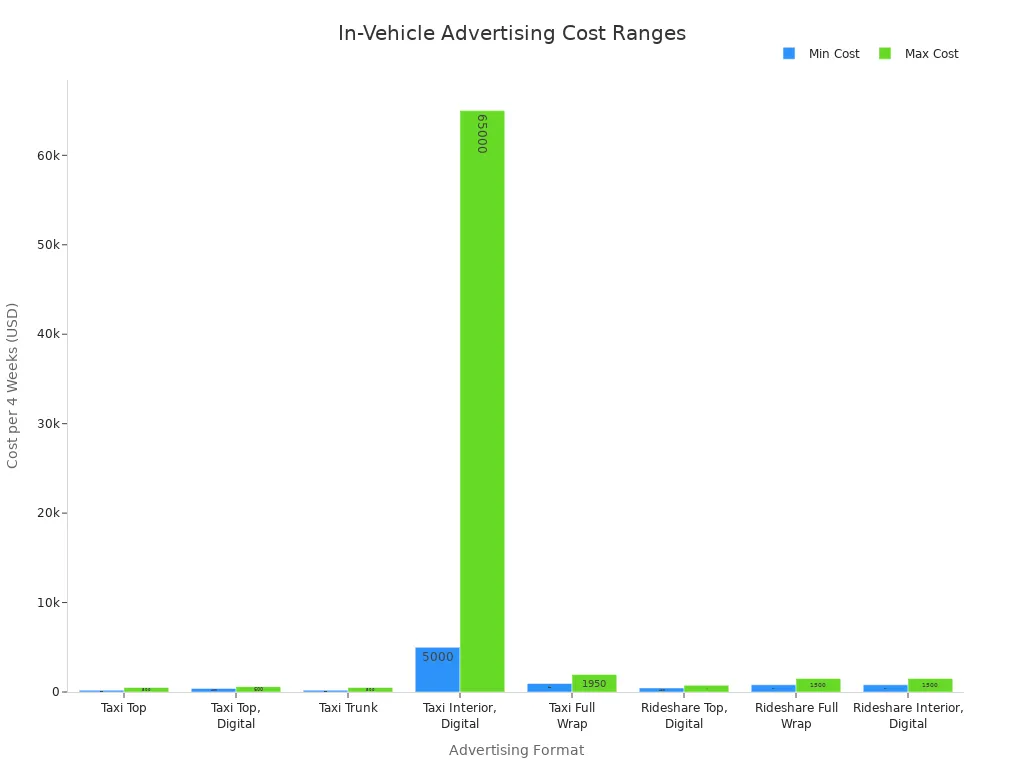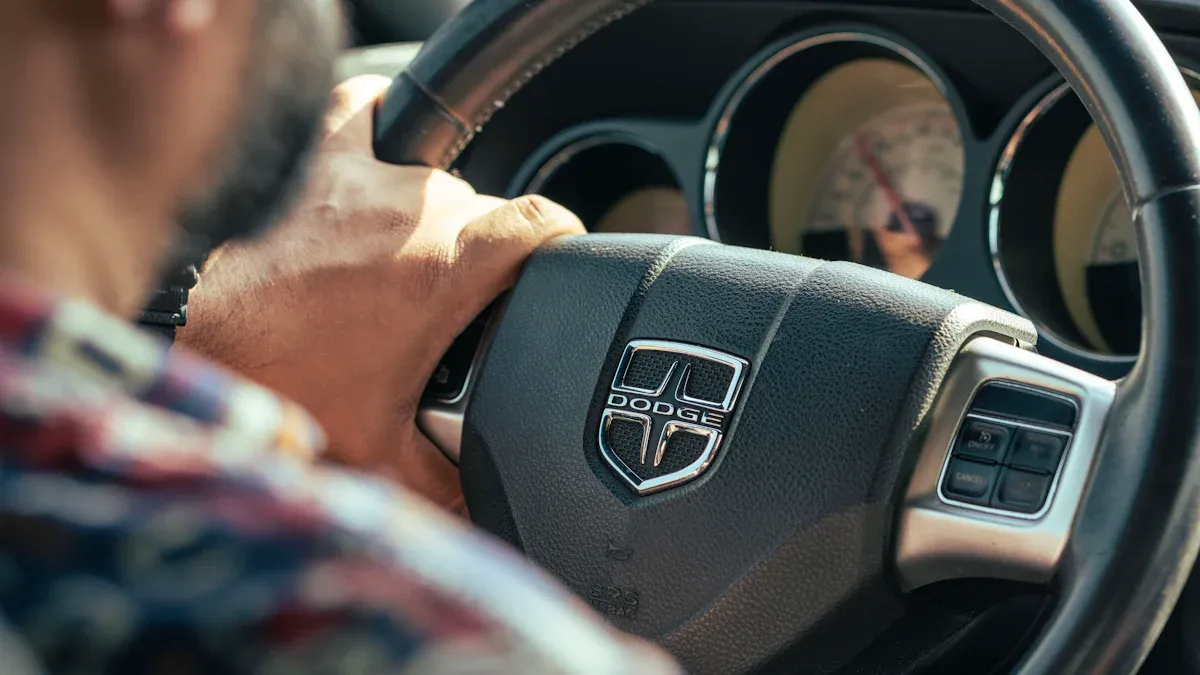
Elevator advertising has experienced significant growth, attracting substantial investment and incorporating new technology. Advertisers are increasingly interested in innovative methods that leverage data, including in-vehicle digital displays. The table below presents the market size and future projections for elevator advertising:
Metric | Value | Details |
|---|---|---|
Elevator Car Advertising Market Size (2024) | Base year 2024 | |
Projected Market Size (2031) | CAGR 4.1% (2025-2031) |
Investment analysis shows that advertisers rely on predictive analytics and performance measurement to guide their spending decisions. This approach ensures ads reach the right audience and deliver measurable results.
Key Takeaways
Elevator advertising is for people who work or live in offices and apartments. It has steady costs and gets good attention when people wait quietly.
In-vehicle advertising reaches many people who travel, like commuters and tourists. It uses digital screens and sound to make ads stronger.
Advertisers like in-vehicle ads with video and sound. They use AI and real-time data to change ads fast and get better results.
Using both elevator and in-vehicle ads with smart tools helps brands reach more people. It keeps messages the same and helps spend money better.
Changing ads by location, time, and weather gets more attention. This makes campaigns work better on both channels.
Investment Analysis

Elevator Advertising Costs
Elevator advertising costs are not the same everywhere. The price changes based on where you are and what kind of building it is. Many things can make the cost go up or down:
The type of building changes what elevators need. Office buildings often need fast and big elevators. Hospitals need elevators with special safety parts. Hotels may want fancy elevators that look nice and do more than one job.
The kind of elevator, like hydraulic or traction, changes how much it costs to put in and keep working.
If a building has more floors, it needs better motors and cables. This makes the elevator more expensive.
If you want special things like fancy walls or smart systems, it will cost more.
Labor costs are different in each place. Cities usually have higher labor prices.
Changing the building, getting permits, and paying for service also add to the total cost.
Note: Putting new elevator ads in old buildings is harder and costs more because of building problems.
Elevator advertising needs a lot of money at the start. For example, the world elevator ad market was $1.9 billion in 2024. It may grow to $3.5 billion by 2033. In Germany, more buildings are using digital elevator screens. Companies spend a lot on new tech, safety, and saving energy to get more advertisers.
In-Vehicle Advertising Costs
In-vehicle advertising comes in many types and prices. The cost depends on the vehicle, ad type, how long the ad runs, and the tech used. Taxi ads can be small, like tip seats, and start at $30-$35. Full taxi wraps can cost up to $1,950. Electric taxis cost more because they are better for the environment. Ride-share cars like Uber and Lyft have digital top ads and full wraps. These cost between $450 and $1,500.
Advertising Format | |
|---|---|
Taxi Top | $200 – $500 |
Taxi Top, Digital | $400 – $600 |
Taxi Trunk | $200 – $500 |
Taxi Interior, Digital (per fleet) | $5,000 – $65,000 (depending on spot length) |
Taxi Full Wrap | $950 – $1,950 |
Rideshare (Uber/Lyft) Top, Digital | $450 – $750 |
Rideshare (Uber/Lyft) Full Wrap | $800 – $1,500 |
Rideshare (Uber/Lyft) Interior, Digital | $800 – $1,500 |

Adding tech like digital screens and sound changes the price. Good digital screens need light sensors and cooling systems. These help save energy and make the screens last longer. This can lower costs over time. Sound that matches the screen can make ads work better and help companies earn more. But, new tech and following rules can make starting costs higher, especially when adding new things to cars.
ROI Comparison
Both elevator and in-vehicle ads can give good returns. Which one is better depends on your goals and who you want to reach. Elevator ads are easy to see in places like offices and apartments. They cost more at first, but the cost to keep them running is steady.
In-vehicle ads can move and reach many people in busy places. Digital screens and sound make these ads more interesting. This is good for brands that want to try new things. Studies show that using sound with digital ads can help brands get over 20% more local sales.
Advertisers are ready to pay more for new in-vehicle ad types, especially those with video and sound. If you buy more ads or run them longer, you can save money. Investment analysis shows in-vehicle ads help brands reach more people and get more attention without spending too much.
Tip: Brands should use tools to check how well ads work and plan better for the future.
Audience & Engagement

Elevator Audience Demographics
Elevator advertising is seen by special groups in cities and suburbs. Many viewers are young workers in jobs like finance, marketing, healthcare, and law. These people often live in fancy apartments or work in top office buildings. They usually make more money and like brands and new tech.
Audience Segment | Key Demographic Characteristics | Occupation Types | Income Level | Lifestyle & Interests | Notable Networks & Features |
|---|---|---|---|---|---|
Urban Commuters | Finance, marketing, healthcare, law | $75k+ household | Pet ownership, brand affinity, tech | theBulletin (8,000+ screens), Vertical Impression (avg. 118 sec captive audience), Touchsource (1,200+ screens) | |
Suburban Remote Workers | Professionals in suburban offices | Similar to urban | Similar range | Purchase habits, lifestyle interests | theBulletin, Touchsource |
People look at elevator screens for about 118 seconds each ride. Networks use tenant info to show ads to certain jobs or skills. This helps ads reach the right people.
In-Vehicle Audience Demographics
In-vehicle ads reach many people who move around a lot. The main groups are:
Tourists and visitors in cities
City people who use transit for work or fun
A lot of these viewers are Millennials and Generation Z. They like tech, easy things, and being online. Men, young adults, and people with more money use ride-share and car-share more. Having kids changes how families see these ads, since they may use these rides in other ways.
Note: In-vehicle ads can reach people in many places and change with travel times during the day.
Engagement Metrics
Elevator ads keep people close to the screen. This makes it easier for them to see and remember ads. People spend more time looking and remember more than with other outdoor ads. Digital elevator screens can have games or connect to phones. This makes people interact more and lets companies change ads fast.
In-vehicle ads use moving cars to show ads to more people. Rideshare cars go through busy places and follow where people are. GPS and ride info help show ads in crowded spots at busy times. This way, more people see the ads and they fit into daily life.
Tip: Both elevator and in-vehicle ads use digital tools to check how well ads work, make better plans, and send the right message at the best time and place.
Advertiser Preferences
Channel Selection Trends
Advertisers are now choosing in-vehicle advertising more often. They like ads that use both screens and radio together. Surveys show 80% of advertisers want screens that work with sound. This shows people want ads that use more than one sense during rides.
Car brands use new things like VR, AR, and 3D displays. These make fun experiences, like fake test drives, to get people interested.
AI helps brands show ads that fit what each person likes. AI looks at data to make ads feel special for everyone.
Programmatic ad buying lets brands put ads in the right place fast. This helps them reach more people and get better results.
Many brands now pick digital channels, like social media and video. These let brands make ads that people can interact with and track.
More electric vehicles mean ads talk more about tech and being green. This is important to people who care about the planet.
Advertisers think in-vehicle ads are good for reaching people who like tech and move around a lot. They like that these ads can change and use new ideas.
Key Decision Factors
Advertisers look at many things when picking elevator or in-vehicle ads. Many will pay more for in-vehicle ads with sound and video. These ads help people remember brands better.
Brands use real-time data, AI, and smart tools to find the right people. These tools help brands change ads fast and get better results. By knowing what people want and what is happening in their lives, brands can make ads feel just right.
Note: Using data helps brands spend less money on bad ads and make their ads work better everywhere.
Strategic Recommendations
When to Use Elevator Advertising
Elevator advertising works well where people have to wait. Fancy apartment buildings and big office towers are good places. These spots have business people, leaders, and parents who earn a lot. People ride elevators for 30 seconds to two minutes. This quiet time helps brands get noticed and remembered.
Use elevator ads to help people know your brand and find new customers.
Pick screens by job, money, or where people live to reach the right group.
Show ads that match what people see, like money ads during business news.
Add things like QR codes so people can join in and act fast.
Elevator ads always get seen. Brands can reach important people and see clear results. This type of ad is good for brands that want to talk to rich, working people.
When to Use In-Vehicle Advertising
In-vehicle ads reach people who are going places. These ads are good for brands that want to talk to commuters, tourists, and city people. Digital screens and sound make these ads easy to notice. Brands use these ads to show new things or special deals.
Pick in-vehicle ads to reach people who like tech and move around a lot.
Use ads that change with place, time, or weather.
Use video and sound together so people remember the ads better.
Advertisers pay more for new ad styles in cars. These ads help brands stay in people’s minds while they travel.
Integrated Strategies
Brands do best when they use both elevator and in-vehicle ads. Tools can help brands see how both ad types work together. Marketers can see which ads do well and spend money in smarter ways.
Use tools to watch how ads do and make campaigns better.
Keep the same look and message in all ads.
Check how each ad type works to spend money wisely.
Tip: Using both ad types with good tools helps brands see how well ads work and get the most from their money.
Investment analysis finds elevator advertising is best for brands wanting to reach workers in offices or people living in nice apartments. In-vehicle ads are better for brands that want to talk to people who move around a lot and like technology. Advertisers should:
Split the audience into groups and use location data to find the right people.
Change ads to fit things like the time of day or the weather so more people pay attention.
Use ads on different channels together to make the brand stronger.
Watch real-time data to make ads work better and get more value.
Using data and technology in smart ways helps brands reach more people and see how well their ads are doing.
FAQ
What is the main benefit of elevator advertising?
Elevator advertising shows ads to people in offices and apartments. Many of these people make more money than others. They spend more time looking at screens in elevators. Brands can talk to workers and leaders in a quiet place. This helps brands get noticed by important people.
How does in-vehicle advertising reach its audience?
In-vehicle ads show up in taxis, rideshares, and buses. These ads travel through busy city streets every day. They reach people who go to work, visit cities, or like technology. Brands can change ads for different times and places.
Which channel offers better engagement rates?
Research says elevator ads hold people’s attention longer. In-vehicle ads reach more people but for less time. Both types use digital tools to see how well ads work and make them better.
How do advertisers measure the success of these ads?
Advertisers use digital dashboards and special tools. They count how many people see and click on ads. They also look at who is seeing the ads. Real-time data helps brands change ads fast to get better results.
See Also
Comparing Wireless CarPlay Adapters And AI Boxes For Value
Best AI Video Boxes For Vehicles Reviewed In 2025
Reviewing The Best CarPlay Adapters For 2023 Ford F-150
Audi Tesla-Style CarPlay Screens Compared By Features And Cost
CarPlay Options Explored For BMW F30 Infiniti And Universal Cars
